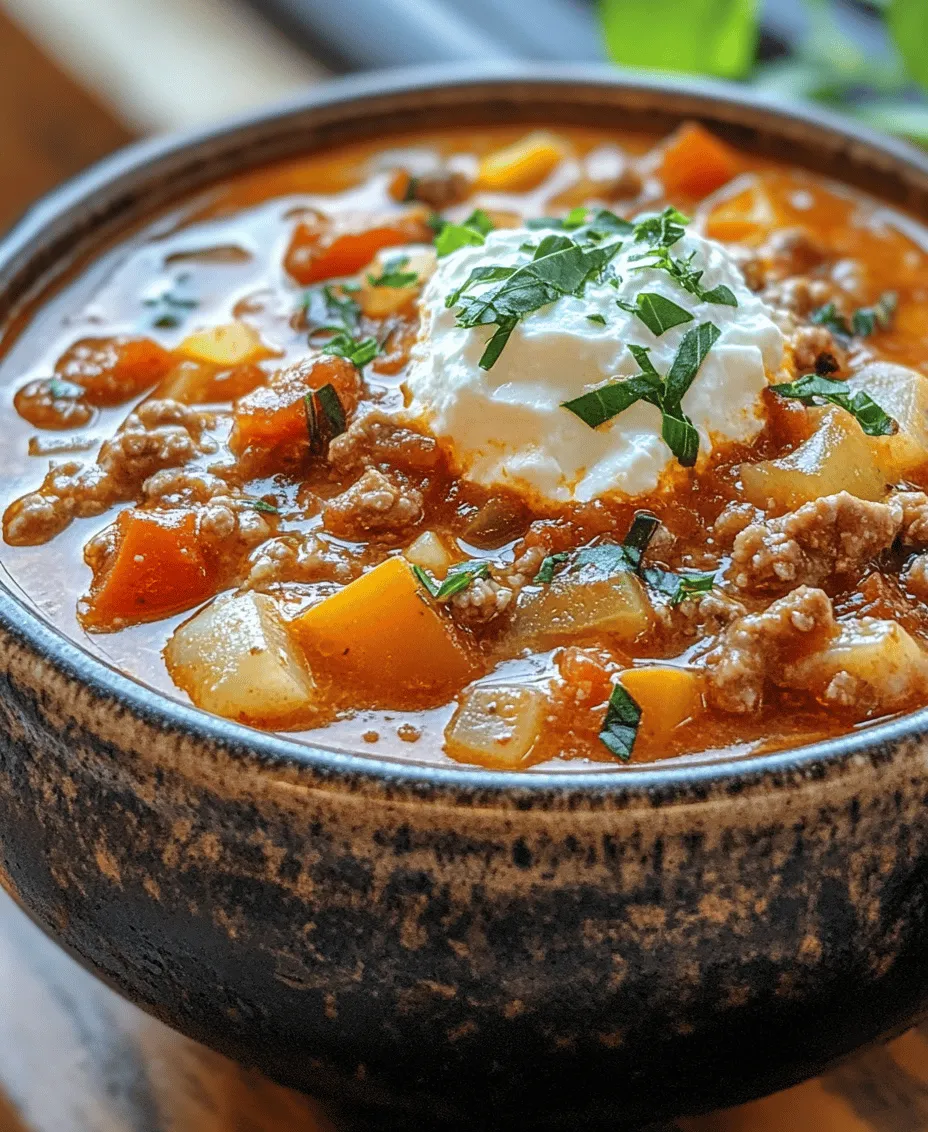Introduction
As the cold weather sets in, there’s nothing quite like a warm bowl of soup to evoke feelings of comfort and homeliness. Soup has a magical way of warming us from the inside out, making it a quintessential dish for family gatherings or cozy weeknight dinners. Among the myriad of soup options available, lasagna soup stands out as a delightful twist on a classic Italian favorite. Imagine the rich flavors of lasagna, with its layers of cheese, pasta, and savory meat, transformed into a hearty soup that is both satisfying and easy to prepare.
This warm and cozy lasagna soup is not only a treat for the taste buds but also a breeze to make, requiring minimal prep time while delivering maximum flavor. It’s the kind of dish that brings everyone together, filling the kitchen with enticing aromas and inviting conversation. Whether you’re hosting friends, feeding a family, or simply looking for a comforting meal after a long day, this lasagna soup is sure to hit the spot.
The Comfort of Soup: Why We Love It
There’s an undeniable emotional and physical comfort that comes from enjoying a bowl of hot soup, especially during the chilly months of fall and winter. Soups have been cherished for centuries across cultures, often associated with home-cooked meals and family traditions. They provide warmth, nourishment, and a sense of nostalgia, reminding us of cozy evenings spent with loved ones around the dinner table.
In recent years, there’s been a growing trend of transforming traditional dishes into soup form. This innovative approach allows home cooks to enjoy classic flavors in a more convenient and accessible way. Lasagna soup is a perfect example of this trend, as it captures all the beloved elements of lasagna—rich tomato sauce, creamy cheeses, and hearty pasta—in a single pot. This recipe not only streamlines the cooking process but also enhances the flavors, as the ingredients simmer together, creating a harmonious blend that is both comforting and delicious.
Ingredients Breakdown: What You’ll Need for Lasagna Soup
To create the perfect lasagna soup, you’ll need a variety of ingredients that work together to build flavor and texture. Let’s break down the essential components of this cozy dish:
– Ground Beef vs. Italian Sausage: The choice of meat can significantly affect the flavor profile of your soup. Ground beef offers a classic taste, while Italian sausage brings a spicy, aromatic quality. You can mix both for a more complex flavor, or opt for turkey or chicken for a lighter option.
– Fresh Herbs and Spices: Fresh herbs like oregano and basil are crucial for adding depth to the soup. These herbs evoke the essence of traditional Italian cooking and elevate the dish from ordinary to extraordinary. Red pepper flakes can also be included for a hint of heat, creating a balanced flavor.
– Cheeses: Cheese is a hallmark of any lasagna dish, and this soup is no exception. Ricotta cheese adds a creamy richness that complements the tangy tomato base, while mozzarella provides that gooey, melty texture we all love. Parmesan cheese, sprinkled on top, enhances the overall flavor and adds a touch of sophistication.
– Vegetables: Onions, garlic, and bell peppers form the aromatic base of the soup. Sautéing these vegetables before adding the liquids allows their flavors to develop, creating a more robust soup.
– Broth and Tomatoes: A combination of beef broth and canned tomatoes (diced or crushed) forms the soup’s foundation. The broth adds savory depth, while the tomatoes contribute acidity and sweetness, balancing the richness of the cheese.
– Pasta: Lasagna noodles are typically used in this recipe. They can be broken into smaller pieces and added directly to the soup, cooking perfectly in the simmering broth.
– Optional Ingredient Variations: For those looking to explore vegetarian or plant-based substitutes, consider using lentils or plant-based ground meat alternatives. You can also add extra vegetables like spinach or zucchini for added nutrition and flavor.
Step-by-Step Instructions: How to Make Warm & Cozy Lasagna Soup
Creating this warm and cozy lasagna soup is a straightforward process, but each step is essential for achieving the perfect balance of flavors and textures. Follow these detailed instructions to guide you through the cooking process:
Step 1: Brown the Meat
Start by browning your choice of meat in a large pot or Dutch oven over medium heat. If you’re using ground beef, break it apart with a wooden spoon, allowing it to cook evenly. For Italian sausage, remove the casing and crumble the meat into the pot.
Tips for Perfect Texture and Flavor:
– Avoid overcrowding the pot; if you have a large amount of meat, consider browning it in batches.
– Allow the meat to sear without stirring for a couple of minutes. This helps develop a rich flavor and a nice browning, which adds depth to the soup.
Step 2: Sauté the Vegetables
Once the meat is browned and cooked through, drain any excess fat if necessary. Add chopped onions, minced garlic, and diced bell peppers to the pot. These vegetables will form the aromatic base of your soup.
The Importance of Developing Flavors:
– Sauté the vegetables for about 5-7 minutes, or until they are soft and fragrant. This step is crucial as it helps to build the soup’s flavor profile.
– Stir occasionally to prevent the garlic from burning, as burnt garlic can impart an unpleasant bitterness to the dish.
Step 3: Add the Herbs and Spices
After the vegetables have softened, it’s time to add your herbs and spices. Sprinkle in dried oregano, basil, and red pepper flakes. Stir well to combine, allowing the herbs to infuse their flavors into the mixture.
Step 4: Combine the Broth and Tomatoes
Next, pour in the beef broth and add your canned tomatoes (diced or crushed). Stir everything together, scraping the bottom of the pot to release any browned bits that may have stuck during the cooking process. These bits add extra flavor to your soup.
Step 5: Incorporate the Pasta
Break the lasagna noodles into smaller pieces and add them to the pot. Stir to ensure they are submerged in the broth.
Step 6: Simmer
Bring the soup to a gentle boil, then reduce the heat to low. Cover the pot and let the soup simmer for about 20-25 minutes, or until the pasta is tender. Stir occasionally to prevent the noodles from sticking together.
Step 7: Finish with Cheese
As the soup nears completion, stir in the ricotta and mozzarella cheese until melted and creamy. This step adds a luxurious texture that mirrors the experience of eating traditional lasagna.
With these steps, you are well on your way to creating a warm and cozy lasagna soup that will delight your family and friends. The combination of flavors and the comforting nature of this dish make it a perfect choice for any occasion, from chilly weeknights to festive gatherings. Stay tuned for the next part of this article, where we’ll explore more tips for success and answer some common questions about this delightful recipe.

Creating the Broth Base: Balance of Flavors and Consistency in Soup
The foundation of any great soup lies in its broth. For our Warm & Cozy Lasagna Soup, achieving a rich and flavorful broth is paramount. Start by heating olive oil in a large pot over medium heat, then add finely chopped onions, minced garlic, and diced bell peppers. Sauté these ingredients until they are soft and fragrant, which typically takes about 5-7 minutes.
Next, incorporate ground meat, such as beef or turkey, breaking it apart as it cooks. Season the meat with Italian seasoning, salt, and pepper to enhance the flavor profile. Once the meat is browned, add crushed tomatoes, tomato paste, and chicken or vegetable broth. Ensure that the broth has a well-balanced flavor by allowing it to simmer for at least 20 minutes. This will help meld the flavors together and create a cohesive base. Taste and adjust the seasoning as necessary, adding a touch of sugar if the tomatoes are overly acidic.
To achieve the desired consistency, you want the broth to be savory yet slightly thickened. If it appears too thin, let it simmer uncovered for a little longer to reduce. On the other hand, if it’s too thick, a splash of water or broth can help reach the perfect soup texture.
Cooking the Noodles: Ensuring the Right Texture and Preventing Clumping
When it comes to the noodles, the goal is to maintain their integrity while preventing clumping. For lasagna soup, using mini lasagna noodles or broken pieces of traditional lasagna sheets works wonderfully.
Cook the noodles separately according to the package instructions, ensuring they are al dente. This is crucial because they will continue to soften when added to the hot soup. Avoid overcooking them, as they will absorb some broth and become mushy if cooked for too long.
Once the noodles are cooked, drain them and toss them with a drizzle of olive oil to prevent sticking. When ready to serve, you can either add the noodles directly to the soup pot or serve them in individual bowls, ladling the broth and toppings over the noodles. This method not only keeps the noodles from clumping but also allows for better portion control.
Incorporating the Cheese Mixture: Techniques for Achieving a Creamy Consistency
A signature element of lasagna soup is the creamy cheese mixture that brings a comforting richness to each bowl. To create this mixture, combine ricotta cheese, grated Parmesan, and shredded mozzarella in a mixing bowl. You can enhance the flavor by adding fresh herbs like parsley or basil, along with a pinch of salt and pepper.
To achieve a creamy consistency, it’s best to mix the cheeses until they’re smooth. If you desire an even silkier texture, consider whisking in a small amount of heavy cream or milk. This will help the cheese blend seamlessly into the soup, providing that luscious mouthfeel characteristic of traditional lasagna.
When serving, you can either stir the cheese mixture directly into the soup or dollop it on top of the individual servings. The latter option creates a beautiful presentation and allows each diner to mix in the cheese to their liking.
Serving Suggestions: Making the Most of Your Lasagna Soup
Presentation is key when serving lasagna soup. Consider using wide, shallow bowls to showcase the vibrant colors of the soup and toppings. For an appealing touch, sprinkle additional shredded cheese and freshly chopped herbs, such as basil or parsley, on top before serving.
Accompanying side dishes can enhance your dining experience. Garlic bread is a classic pairing that complements the flavors of the soup while providing a satisfying crunch. A fresh salad made with mixed greens, cherry tomatoes, and a light vinaigrette adds a refreshing contrast to the hearty soup.
For a finishing touch, consider garnishing the soup with a drizzle of olive oil or a sprinkle of red pepper flakes for an extra kick. These small details not only elevate the dish visually but also enhance the overall flavor.
Nutritional Insights: A Closer Look at Lasagna Soup
Lasagna soup is not only delicious but also packed with nutritional benefits. The primary ingredients contribute a variety of nutrients essential for a balanced diet. Ground meat provides a good source of protein, which is crucial for muscle repair and immune function. The addition of vegetables like onions and bell peppers offers vitamins A and C, while the tomatoes are rich in antioxidants, particularly lycopene.
Dairy from the cheese mixture is an excellent source of calcium, promoting healthy bones and teeth. However, for those who may be health-conscious, there are several modifications to consider. You can opt for low-fat cheese varieties to reduce calories and saturated fat. Additionally, increasing the vegetable content by adding spinach or zucchini can boost fiber and nutrient intake without compromising flavor.
By making these adjustments, you can create a lasagna soup that caters to various dietary needs while still maintaining its comforting essence.
Storing and Reheating Lasagna Soup: Tips for Meal Prep
One of the great things about lasagna soup is its suitability for meal prep. If you find yourself with leftovers, storing them properly is essential to preserve freshness and flavor. Allow the soup to cool to room temperature before transferring it to an airtight container. It can be stored in the refrigerator for up to four days.
When it comes to reheating, the best method is to transfer the soup to a pot and heat over low to medium heat, stirring occasionally. This gentle reheating helps maintain the texture of the ingredients. Alternatively, you can use the microwave, but be sure to heat in short intervals, stirring in between to ensure even warming.
If you wish to freeze the soup for future meals, it’s best to do so before adding the noodles. This prevents the pasta from becoming mushy upon thawing. Store the cooled soup in freezer-safe containers, leaving some space at the top as the soup will expand when frozen. It can be stored in the freezer for up to three months. To reheat, defrost in the refrigerator overnight and follow the same reheating methods mentioned above.
Conclusion
Lasagna soup is a warm, comforting dish that brings the best of two worlds—hearty lasagna and flavorful soup—into one satisfying bowl. Its rich broth, tender noodles, and creamy cheese mixture create a delightful experience that is easy to prepare and perfect for sharing with loved ones. Cooking and enjoying meals together fosters connection, making lasagna soup not just a recipe, but a cherished experience to be savored.
As you gather around the table with family or friends, savoring each spoonful of this delicious soup, remember that the joy of cooking lies in the memories created and the love shared. So, embrace the warmth and comfort of lasagna soup, and enjoy every moment spent in the kitchen and at the dining table.


